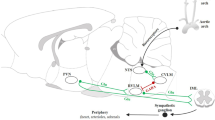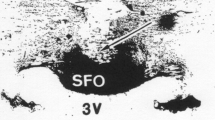Abstract
1. Current evidence supports that C-type natriuretic peptide (CNP) is the brain natriuretic peptide. Natriuretic peptide receptors and mRNA CNP have been reported in the liver and in discrete areas and nucleus of the central nervous system involved in the regulation of gastrointestinal physiology. In the present work, we sought to establish the role of CNP in the central regulation of bile secretion in the rat and to delineate the possible pathways and mechanisms involved.
2. To examine the role of CNP on bile secretion, the peptide was applied in the brain lateral ventricle (1, 10, and 100 ng/μL) and bile samples were collected every 15 min for 60 min. The role of the autonomic nervous system in CNP response was assessed by atropine or combined phentolamine and propranolol administration.
3. Centrally applied CNP diminished basal as well as bile salt-evoked bile flow in a dose-dependent manner. CNP reduced bile acid output as well as sodium and potassium excretion, supporting CNP effect on bile acid-dependent flow. CNP also decreased chloride excretion and increased bile pH. The excretion of total glutathione was not affected by centrally applied CNP suggesting that this peptide does not alter bile acid-independent flow. Neither parasympathetic nor sympathetic blockade abolished CNP inhibitory response on bile secretion. Mean arterial pressure and portal venous pressure were not modified by CNP.
4. Present findings show that centrally applied CNP modulates bile secretion in a dose-dependent fashion. CNP alkalinized bile and reduced bile acid-dependent flow without affecting bile acid-independent flow. The inhibitory response of CNP on bile secretion was not mediated by the autonomic nervous system. Present findings give further support to the role of CNP as the brain natriuretic peptide.
Similar content being viewed by others
REFERENCES
Anand-Srivastava, M. B., and Trachte, G. J. (1993). Atrial natriuretic factor receptors and signal transduction mechanisms. Pharmacol. Rev. 45:455–497.
Balabaud, C., Noel, M., Beraud, C., and Dangoumau, J. (1975). Circadian rhythm of bile secretion in the rat. Experientia 31:1299–1303.
Beckh, K., and Arnold, R. (1991). Regulation of bile secretion by sympathetic nerves in perfused rat liver. Am. J. Physiol. 261:G775–G780.
Bianciotti, L.G., Elverdín, J.C., Vatta, M. S., and Fernández, B. E. (1996). Atrial natriuretic factor modifies the composition of induced-salivary secretion in the rat. Regul. Pept. 65: 139–143.
Bianciotti, L.G., Vatta, M. S., Elverdín, J. C., Di Carlo, M. B., Negri,G., and Fernández, B. E. (1998). Atrial natriuretic factor-induced amylase output in the rat parotid gland is mediated by inositol phosphate pathway. Biochem. Biophys. Res. Commun. 247:123–128.
Bianciotti, L. G., Vatta, M. S., Vescina, C., Trippodi, V., Sabbatini, M. E., and Fernández, B. E. (2001). Centrally applied atrial natriuretic factor diminishes bile secretion in the rat. Regul. Pept. 102:127–133.
Bouscarel, B., Kroll, S. D., and Fromm, H. (1999). Signal transduction and hepatocellular bile acid transport: Cross talk between bile acids and second messengers. Gastroenterology 117:433–452.
Bruusgaard, A. P. (1970). Quantitative determination of the major 3-hydroxy bile acids in biological materials after thin layer chromatographic separation. Clin. Chim. Acta 28:495–504.
Chabot, J. G., Morel, G., Kopelman, H., Belle-Isles, M., and Heisler, S. (1987). Atrial natriuretic factor and exocrine pancreas: Autoradiographic localization of binding sites and ultrastructural evidence for internalization of endogenous ANF. Pancreas 2(4):404–413.
Charles, C. J., Espiner, E. A., Richards, A. M., Nicholls, M. G., and Yandle, T. G. (1995). Biological actions and pharmacokinetics of C-type natriuretic peptide in conscious sheep. Am. J. Physiol. 268:R201–R207.
Fernández, B. E., Bianciotti, L.G., Vatta, M. S., Dominguez, A. E., and Vescina,C. (1993). Atrial natriuretic factor modifies bile flow and composition in the rat. Regul. Pept. 143:177–184.
Friman, S., Radberg, G., and Svanvik, J. (1990). Adrenergic influence on bile secretion—an experimental study. Acta Physiol. Scand. 140:287–293.
Furuya, M. (1992). Structural requirements of C-type natriuretic peptide for elevation of cyclic GMP in cultured vascular smooth muscle cells. Biochem. Biophys. Res. Commun. 183:964–969.
Gademann, A., Puschel, G. P., and Jungermann, K. (1992). Nervous control of liver metabolism and hemodynamics. Eur. J. Biochem. 207:399–411.
Gillis, R. A., Quest, J. A., Pagani, F. D., and Norman, W. P. (1989). Central centers in the central nervous system for regulating gastrointestinal motility. In Wood, J. D. (ed.), Handbook of Physiology. Section 6: The Gastrointestinal System, American Physiological Society, Bethesda, Washington, DC, pp. 621–683.
Gower, W. R., Dietz, J. R., Vessely, D. L., Finley, C. L., Scholnick, K. A., Fabbri, P. J. Cooper, D. R., and Chalfant, C. E. (1994). Atrial natriuretic peptide gene expression in the gastrointestinal tract. Biochem. Biophys. Res. Commun. 202:562–570.
Hagenbuch, B., Steiger, B., Foguet, M., Lubbert, H., and Meier, P. J. (1991). Functional expression, cloning and characterization of the hepatocyte NaC/bile acid cotransport system. Proc. Soc. Natl. Acad. Sci. U.S.A. 88:10629–10630.
Janowski, M., Petrone, C., Tremblay, J., and Gutknowska, J. (1996). Natriuretic peptide system in the rat submaxillary glands. Regul. Pept. 62:53–61.
Kojima, M., Minamino,N., Kangawa, K., and Matsuo,H. (1990). Cloning and sequence analysis of acDNA encoding a precursor for rat C-type natriuretic peptide (CNP). FEBS Lett. 276:209–213.
Koller, K. J., and Goeddel, D. V. (1992). Molecular biology of the natriuretic peptides and their receptor. Circulation 86(4):1081–1088.
Komatsu, Y., Nakao, K., Suga, S., Ogawa, Y., Mukoyama, M., Arai, H., Shirakami, G., Hosoda, K., Nakagama, O., Hama, N., Kishimoto, I., and Imura, H. (1991). C-type natriuretic peptide (CNP) in rats and humans. Endocrinology 129:1104–1106.
Kullak-Ublick, G. A., Stieger, B., Hagenbuch, B., and Meier, P. J. (2000). Hepatic transport of bile salts. Semin. Liver Dis. 20(3):277–292.
Langub, M.C., Jr., Dolgas, C. M., Watson, R. E., Jr., and Herman, J.P. (1995).The C-type natriuretic peptide receptor is the predominant natriuretic peptide receptor mRNA expressed in rat hypothalamus. J. Neuroendocrinol. 7:305–309.
Masuda, M., Kanai, S., Miyasaka, K., and Funakoshi, A. (1995). Somatostatin inhibits pancreatic exocrine secretion centrally via sympathetic nerves in conscious rats. J. Auton. Nerv. Syst. 56:31–37.
Matejka, M., Vescina, C., and Alayon, A. (1987). Micrométodo para la determinación de fosfolípidos en bilis humana. Acta Bioquim. Latinoamer. 21:351–355.
Middendorff, R., Maronde, E., Paust, H.-J., Muller, D., Davidoff, M., and Olcese, J. (1996). Expression of C-type natriuretic peptide in the bovine pineal gland. J. Neurochem., 67:517–524.
Nagain, C., Chariot, J., and Roce, C. (1993). Mechanism of neurotensin of external pancreatic secretion in the rat. Pancreas 8(3):346–353.
Paxinos, E., and Watson, J. (1986). The Rat Brain Stereotaxic Coordinates. Academic Press, Sydney, Australia.
Puyó, A. M., Vatta, M. S., Donoso, A. S., Bianciotti, L.G., and Fernández, B. E. (2000). Central natriuretic peptides regulation of peripheral atrial natriuretic factor release. Regul. Pept. 90:93–99.
Rambotti, M.G., Giambanco, I., and Spreca, A. (1997). Detection of guanylate cyclasesAandBstimulated by natriuretic peptides in gastrointestinal tract of rat. Histochem. J. 29:117–126.
Rodríguez-Fermepín, M., Vatta, M. S., Bianciotti, L.G., Wolovich, T., and Fernández, B. E. (2000). B-type and C-type natriuretic peptides modify norepinephrine uptake in discrete encephalic nuclei of the rat. Cell. Mol. Neurobiol. 20(6):763–771.
Stepan, H., Leitner, E., Siems, W.-E., Maul, B., and Walther, T. (1999). RNA quantification of C-type natriuretic peptide in brain areas of rodents. Peptides 20:1243–1245.
Sudoh, T., Minamino, N., Kangawa, K., and Matsuo, H. (1990). C-type natriuretic peptide (CNP): A new member of the natriuretic peptide family identified in porcine brain, Biochem. Biophys. Res. Commun. 168:863–870.
Suga, S. I., Itoh, H., Komatsu, Y., Ogawa, Y., Hama, N., Yoshimasa, T., and Nakao, K. (1993). Cytokine-induced C-type natriuretic peptide (CNP) secretion from vascular endothelial 22 cells— evidence for CNP as a novel autocrine/paracrine regulator from endothelial cells. Endocrinology 133:3038–3041.
Suga, S., Nakao, K., Hosoda, K., Mukoyama, M., Ogawa,Y., Shirakami,G., Arai, H., Saito,Y., Kambayashi, Y., Inouye, K., and Imura, H. (1992). Receptor selectivity of natriuretic peptide family, atrial natriuretic peptide, brain natriuretic peptide and C-type natriuretic peptide. Endocrinology 130:229–239.
Suzuki, E., Hirata, Y., Hayakawa, H., Omata, M., Kojima, H., Kangawa, K., Minamino, H., and Matsuo, H. (1993). Evidence for C-type natriuretic peptide production in rat kidney. Biochem. Biophys. Res. Commun. 192:532–538.
Tietze, F. (1969). Enzymatic method for quantitative determination of nanogram amounts of total and oxidized glutathione: Applications to mammalian blood and other tissues. Anal. Biochem. 27:502–522.
Vatta, M. S., Presas, M. F., Bianciotti, L. G., Rodriguez-Fermepín, M., Ambros, R., and Fernández, B. E. (1997). B and C-types natriuretic peptides modify norepinephrine uptake and release in the rat adrenal medulla. Peptides 18(10):1483–1489.
Vatta, M. S., Presas, M., Bianciotti, L. G., Zarrabeitia, V., and Fernández, B. E. (1996). B and C-types natriuretic peptides modulate norepinephrine uptake and release in the rat hypothalamus. Regul. Pept. 65:175–184.
Vollmar, A. M., Paumgartner, G., and Gerbes, A. L. (1997). Differential gene expression of the three natriuretic peptides and natriuretic peptide receptors in human liver. Gut 40:145–150.
Vorobioff, J., Bredfeldt, J. E., and Groszmann, J. (1983). Hyperdinamic circulation in portal hypertensive rat model of primary factor for maintenance of chronic portal hypertension. Am. J. Physiol. 244:G52–G57.
Yoneda, M., Tamasawa, N., Takebe, K., Tamori, K., Yokohama, S., Sato, Y., Nakamura, K., Makino, I., and Tache, Y. (1995). Central neuropeptide Y enhances bile secretion through vagal and muscarinic but not nitric oxide pathway in rats. Peptides 16:727–732.
Author information
Authors and Affiliations
Rights and permissions
About this article
Cite this article
Sabbatini, M.E., Vatta, M.S., Vescina, C. et al. Bile Secretion Is Centrally Regulated by C-Type Natriuretic Peptide. Cell Mol Neurobiol 22, 755–770 (2002). https://doi.org/10.1023/A:1021813225723
Issue Date:
DOI: https://doi.org/10.1023/A:1021813225723




